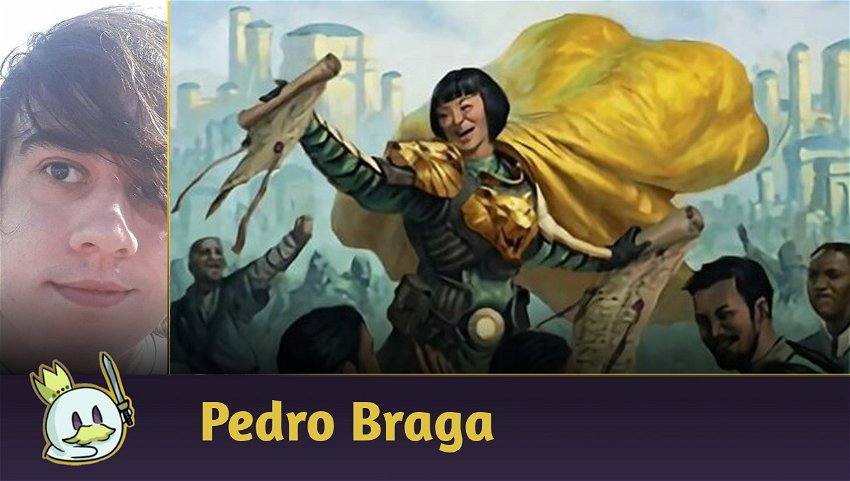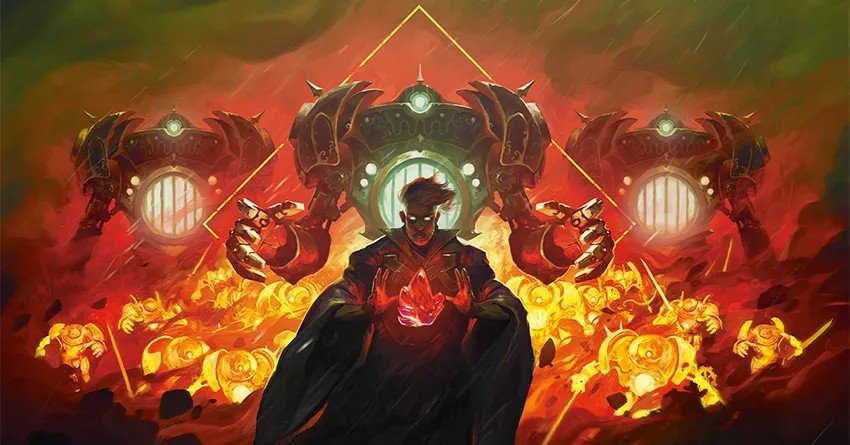In this article, I delved deep into the new set, The Brothers' War, even though I'm not a huge fan of the game's lore. To this day, I don't know what the Urza and Mishra brothers are fighting over, but I do know the best cards in the set to use in their competitive Modern decks.
That's what we'll explore in today's article: the best cards in the set for the format, exploring new ideas to turn them into deadly war weapons.
Honorable Mention — Arcane Proxy
Ad

Arcane Proxy behaves strangely, thanks to the Prototype, which allows it to be cast at a lower cost than what's in the upper-right corner of the card. Casting the card as a Prototype, we have a being that looks a lot like a Snapcaster Mage, has the type, power, toughness, but it's not a Snapcaster.
Its ability to cast free spells from the graveyard is somewhat meaningless due to the lack of Flash, making that Counterspell in your graveyard useless or taking away much of the effectiveness of a Lightning Bolt.
Still, it could perform as a Budget version of the wizard, making it a great replacement when we look at it financially. You can read an analysis of this card here.
5 — Gix, Yawgmoth Praetor

Gix, Yawgmoth Praetor is a great card, but it has a certain dependence on other creatures to get the most out of its capabilities. The ability to trade life for cards is what made cards like Necropotence and Yawgmoth's Bargain so strong. And that's what Gix attempts to replicate.
However, what made these enchantments great was the ability to do their effects multiple times at will, which we and Wizards now know is a bit too strong. Thus, the Praetor gives us the possibility to choose to pay life or not with each creature that hits the opponent. It means that, of course, we need good creatures to attack the opponent.
His second ability costs seven mana, and I can only imagine it being used in the most dragging and time-consuming scenarios in Modern. Even though it's good, it becomes perfect when you have plenty of cards in your hand, which you probably should have gathered through attacks. But what kind of game is that where you have hit multiple times, drawn tons of cards and haven't won yet? Therefore, it fits much more in Commander than in the Modern. But who knows?
Gix, Yawgmoth Praetor is, yeah, really cool. However, the weirdness of how he's driven to his expensive final ability and the fact that he doesn't collaborate with any black deck confines him here, in fifth position.
4 — Myrel, Shield of Argive

Myrel, Shield of Argive has everything to be one of the best cards in the set. Being fully aware that four mana is an absurd amount in today's Modern, this card was almost given an Honorable Mention. But then it occurred to me the existence of Thalia, Guardian of Thraben and Thalia, Heretic Cathar, both capable of slowing down the game well, and on top of being soldiers, which synergizes well with Myrel.
By blocking interactions during your turn, Myrel becomes a threat to control and midrange, forcing them to act slower, which rewards weenie decks with tons of small creatures that make up for it in abilities.
Ad
Myrel also delivers some tokens, and the only way it could get better, would be to create Human Soldiers, instead of simple Soldiers, which would improve its synergy with certain strategies, making it a solid option for Modern.
3 — Phyrexian Fleshgorger

Here we have a very interesting and versatile card. In black midrange decks, they can get it off quickly enough, and Menace coupled with a built-in protection like Ward could make Phyrexian Fleshgorger a force to be reckoned with.
On the other hand, its common cost is seven generic mana. That in Modern means what? Exactly, Tron. When Phyrexian Fleshgorger is summoned for that cost, which on Tron means just three lands, the Menace will gets stronger, Lifelink gives more life, and its Ward will practically become a Hexproof.
Words fail me to describe how amazing this card can be as an out in the deck that always has a better topdeck, something that Tron always masters. Phyrexian Fleshgorger can be wonderful for the deck, perhaps helping to give it a boost, as a variable for the already known Wurmcoil Engine, or even as an additional threat on its sideboard to fetch with Karn.
2 — Haywire Mite

Still in artifacts, we have one that might see tons of play. Haywire Mite has the promising ability to exile non-creature artifacts and enchantments for the low cost of one mana, which immediately indicates its ability to deal with Urza's Saga and all the by-products from it for a low cost.
Decks like Hammer Time, which are at the top of the Metagame, suffers by having many targets against it, such as Colossus Hammer, Batterskull and since it exiles and doesn't destroy, it can even take Kaldra Compleat present in the deck or deal with dangerous threats from other strategies, such as Heliod, Sun-Crowned, when it usually isn't a creature.
A low-cost exile is always an extremely versatile and welcome ability, as seen in Swords to Plowshares, but when attached to a body that can be sacrificed, such as in Sakura-Tribe Elder it is possible to create great plays where damage is prevented through blocks and the creature sacrificed soon after. Combined with the fact it can be found by Urza's Saga and Karn, the Great Creator makes this one a standout card for Modern.
1 — Diabolic Intent

My original intent was to put Haywire Mite in this position, since it was a cheap card with a simple, strong, accurate effect that would fit most green decks on the Sideboard. That said, Diabolic Intent is a cheap card with a simple effect, strong, accurate and fits most black decks on the Mainboard.
A reprint from Planeshift, this spell has the effect of allowing you to sacrifice a creature, then search your deck for any card, putting it in your hand. Therefore, we can consider the card as a great tutor.
And, making it clear early on, a good tutor is strong in any format. The ability to search your deck for any card and put it in your hand, or even on top of it, is atrocious against your opponents, especially when it comes to cards with no limitations. The possibility to choose from a land that you need and up to a card that will define your game, like a Temur Battle Rage, is impressive.
Ad
Even with limitations, such as the need to sacrifice a creature, or sorcery-speed, we can clearly see how this card can affect format. Therefore, I see it as the best card in The Brothers' War for Modern.
Conclusion
Lay Down Arms

I've seen some comparisons of Lay Down Arms with Path to Exile and Swords to Plowshares, for its low cost. Instead of dedicating an honorable mention position just for that, I come here in my cozy little space to talk about it. Comparing the new white spell with the other two ends up not making much sense, that's because the main quality of these low-cost exiles is their instant-speed and lack of necessary conditions.
As much as, yes, Lay Down Arms can be useful in formats without the aforementioned spells, it's still a sorcery that depends on the number of Plains you control, which hurts it heavily to deal with bigger threats.
Good night everyone, and don't run Lay Down Arms on Modern.
Until next time!








— Comments0
Be the first to comment